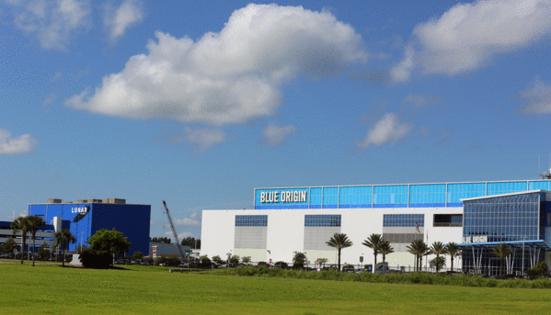Blue Origin's new Space Coast moon lander factory open for business
Published in Business News
MERRITT ISLAND, Florida — Jeff Bezos’ Blue Origin has sunk $3 billion to build up its manufacturing plant and launch pad on the Space Coast in the last decade. On Friday, it invited visitors for a rare media tour of the plant where it constructs its heavy-lift New Glenn rockets while touting its latest addition: the facility where the company will construct its Blue Moon lander to take astronauts back to the lunar surface.
“We have to win this space race. This is the reason why we’re so invested,” said U.S. Rep. Mike Haridopolos, chair of the House Space and Aeronautics Subcommittee, who persuaded Blue Origin to open the factory floor of its massive Brevard County facility. “You can’t help but be confident after seeing firsthand what’s happening here at Blue Origin.”
Blue Origin and Elon Musk’s SpaceX are the competing commercial companies to give NASA working human landing systems for its Artemis program. SpaceX’s Starship is contracted to be the lander for both Artemis III and IV, while Blue Origin’s Blue Moon Mark 2 lander is tapped to fly on Artemis V.
The just-completed Lunar Plant 1, which aims to employ at least another 1,500 people on top of the 4,000 already on the job in Florida, is where the Mark 2 will take shape. As Haridopolos noted, the tour made what at times has seemed like a pie-in-the-sky effort into something impressively real.
“That’s where the Artemis landers will be built,” said John Couluris, Blue Origin’s vice president of its lunar permanence division. “It says lunar specifically, so no one has any doubt what we’re doing here in Florida, that we’re building our lunar landers here.”
Like all the buildings at the sprawling campus just across from the Kennedy Space Center Visitor Center, it’s painted in a vivid blue. It adds another 200,000 square feet to the more than 3 million square feet of space overall at the site.
While the new plant is aimed at constructing a crewed version of its lander, Blue Origin already has a second plant up and running near Port Canaveral called Lunar Plant 2 making the uncrewed Mark 1 version.
And it has plans to send that to the moon this year. Couluris said Mark 1 is headed to Houston first for a review at NASA’s Johnson Space Center’s thermal vacuum chamber.
“We’re going to check it out, make sure it’s good, come out here, do some tests, integrate to New Glenn and then launch by the end of the year, knock on wood,” he said. “But again, that’s that’s assuming everything goes well. We want to make sure we have a successful mission.”
New Glenn is the company’s heavy-lift rocket that made its debut flight this past January from Cape Canaveral Space Force Station’s Launch Complex 36. The rocket’s second flight could come before the end of October with the Mark 1 lunar flight in line as the third mission.
The 322-foot-tall rocket itself is constructed at the largest building on the Merritt Island facility, a 750,000-square-foot factory floor that runs the length of 2 1/2 football fields.
“This is the only place where the rockets and landers are built, right near the launch pad,” Couluris said. “So we’re not shipping across country. We’re not taking delays in transport. But also the people designing and building the vehicles will be operating the vehicles. So you’ve got that knowledge transfer that — ‘I know what that switch does or what that computer is doing’ — and if I have an issue on the pad, the person who actually did it can go out there.”
He also said it’s invaluable to keep the engineers in Florida where the hardware is made.
“There’s so much to be learned by actually touching hardware, going out on the floor, drilling a hole, seeing what people on the floor are doing.” he said.
The New Glenn assembly line spreads out across a stark white floor under hundreds of bright ceiling lights. It is filled with blue-and-gold painted steel contraptions, lined up like a child’s army of Lego creations and holding dozens of rocket parts in various states of completion.
The sounds of pneumatic drills and power saws shearing metal on metal screech in the distance as the occasional alarm blares and massive gantries move along rails more than 100 feet above the floor.
“As you see from the buildings and the infrastructure we’re building here, the Space Coast is perfectly situated to open up the rest of the solar system,” Couluris said. “It starts with low-Earth orbit. It continues on to the moon, which is my program, and then continues on to Mars and the asteroid belts and beyond.”
Haridopolos, in his first term in Congress, praised Blue Origin’s investment on the Space Coast noting Lunar Plant 1 only took 18 months to finish construction.
“It’s an eye opener, and I’m just so impressed how quickly they ramped up,” he said.
He also pointed out the companies are hiring local young people.
“A few weeks ago, I was at Melbourne High School, Eau Gallie High School, Palm Bay High School,” he said. “These kids are getting these certifications, and they come right into these jobs and make $80,000 to $100,000 out of high school. And these are not jobs. These are careers.”
And the investments bode well for the Space Coast’s future, he said.
“When you invest maybe tens of billions of dollars when it’s all over, they’re not going anywhere. And so these aren’t fly-by-night jobs,” he said. “These guys recognize the bottom line, and they’re not going to make this multibillion-dollar investment unless they felt like there’s a commercial opportunity.”
For Blue Origin’s part, it’s ready to support NASA for Artemis V, but would be willing to speed things up if SpaceX faced delays, Couluris said.
“If NASA wants to accelerate us to go faster, then we would ramp that up faster,” he said. “It’s right now gauged on Artemis V. If they want us to go earlier, we would engage a lot faster.”
©2025 Orlando Sentinel. Visit at orlandosentinel.com. Distributed by Tribune Content Agency, LLC.












Comments